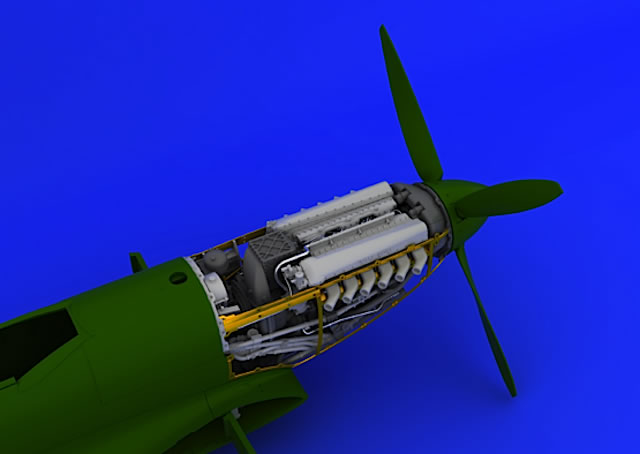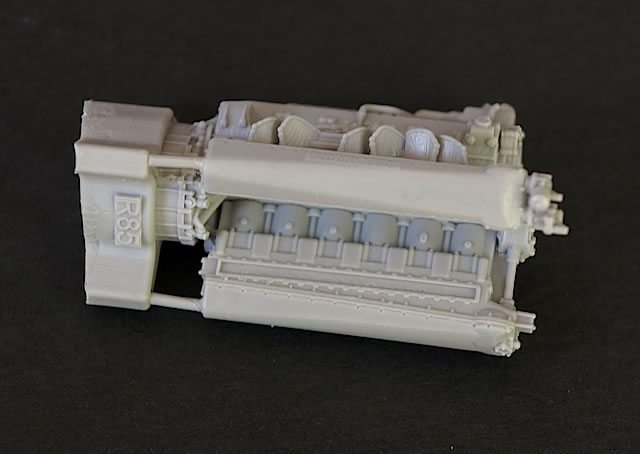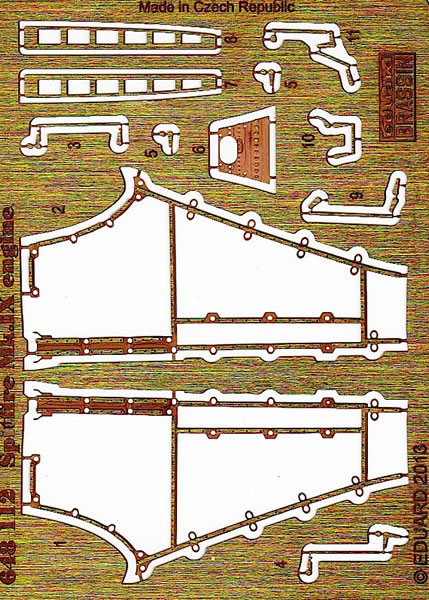Spitfire Mk.IX Engine

CAD image courtesy of Eduard website. Reviewer's photos below.
Eduard BRASSIN, 1/48 scale
S u m m a r y : |
Catalogue Number |
Eduard BRASSIN Item No. 648 112 Spitfire Mk.IX engine |
Contents and Media |
56 light and dark grey resin pieces; one fret of photo-etched brass; 2 x double-sided A4 instruction sheets. |
Scale |
1/48 scale |
Price: |
USD $44.95 plus shipping available online from Eduard’s website and specialist hobby retailers worldwide |
Review Type |
First Look |
Advantages: |
Perfectly cast, highly detailed and well fitting resin parts; comprehensive instructions. |
Disadvantages: |
Spark plug leads cast integrally as part of main engine block, and will be difficult to clean up without damaging. |
Conclusion: |
Contains almost everything you need to create a beautiful miniature Merlin 60-series engine. If you want to add further detail there is scope to do so, but an out of the box build will also deliver excellent results. Highly recommended. |
Reviewed by Brad Fallen

Eduard BRASSIN Bombs are available online from Squadron.com
Eduard’s 1/48 Spitfire Mk.IX (now joined by the Mk.VIII and Mk.XVI) kits are the best quarter-scale Spitfires produced to date. As is now standard practice for Eduard the kits have been designed to accommodate a range of modelling skills. The plastic-only Weekend Editions build into very good replicas, the plastic-and-etch Profipack releases include further detail and Eduard’s dedicated Brassin sets provide options for customisation and super-detailing.
There are also degrees of complexity in the Brassin range. By my count Eduard has now released 18 Brassin sets for its 1/48 Spitfire family. These include drop-fit parts such as wheels, exhausts, drop tanks and bombs, sets that require a little more work to install like radio compartments and gun bays, and mini-kits such as the Mk.IX cockpit set. Brett Green used the cockpit in his build of Eduard’s initial Mk.IXc release and found it “a remarkable little model in its own right” with excellent detail and fit.

The Brassin Spitfire Mk.IX engine set offers comparable levels of finesse, and will give the front end of your Eduard Spitfire a very different look to an out-of-the-box build.
First impressions are rather daunting, with the packaging nearly filled by five bags of resin parts. At this stage it pays to examine the instructions, which are clearly presented in Eduard’s usual style and offer reassurance that the jumble of parts will fit together. Each part is clearly numbered, both in the instructions and on its casting block, and the instructions set out a logical step-by-step process that progressively builds up layers of detail. Gunze paint numbers are used for colour call outs, and while Eduard’s choices here seem reasonable I’d recommend having some references handy to provide confirmation.

Construction begins with a beautifully cast one-piece engine block. This is probably the most impressive part in the set and includes the rocker covers, propeller reduction gear and spark plug leads, along with a number of pumps, filters and other components. My only quibble is with the spark plug leads, which while featuring fine detail are also connected to the cylinders with a thick film of resin that will be tricky to remove without damaging the leads themselves. It might have been more practical – if less ambitious – for Eduard to provide the leads in photo-etch for attachment at the end of the build process. I’ll probably remove the leads on my engine and replace them with lead wire towards the end of the build.
However this is a minor complaint only. It’s clear as construction begins that the engine is a highly detailed mini-kit with parts engineered for a tight and positive fit (very different to some older resin Spitfire engines I have worked with!). Parts that are added to the base engine include:
-
airscrew reduction gear
-
coolant header tank
-
generator
-
magnetos
-
supercharger and carburetor
-
intercooler
-
a choice of exhausts (fishtail or tubular) with associated framework
-
Aero-Vee carburetor intake filter
-
oil tank
-
and major pipes and trunking.
The largely complete engine is then attached to a one-piece firewall (that includes an integrally cast hydraulic reservoir tank and ancillary equipment) and wrapped in a five-part engine frame. The port frame features a radio suppression unit, and the armour plate that protects the glycol tank is well depicted.
Before the engine can be attached to your model, surgery is required on each fuselage half to remove the side cowls, and on the centre front of on the lower wing to remove a small ‘v’ of plastic. If you take care these should be fairly straightforward tasks that leave you with solid mounting points for the Brassin engine.
One of the last jobs is to attach the large but delicate photo-etched panel mounting frames on each side of the engine. Judging by the instructions and reference photos it looks like these frames will require a little manipulation and bending to sit perfectly; in order to achieve this without damage it might help to gently anneal the parts over a candle flame.
Eduard also supplies well cast top, side and lower cowl panels. There are two styles of top panel while the bottom panel has the Aero-Vee intake characteristic of later model Mk.IXs, so check your references for the aircraft you are modelling. I might be wrong but I’d be surprised if these panels were engineered to fit tightly over the engine (a la Tamiya’s 1/32 Spitfires). However, with their finely rendered external and internal details the panels will look most convincing if used in a diorama or vignette.
This set contains engine details I could only dream about when building Airfix’s big 1/24 Spitfire many years ago. It also surpasses other 1/48 resin Spitfire engines I have in the stash, particularly in terms of fit. Yes you’ll need to do some plastic surgery to install the Brassin engine, but Eduard has designed its Spitfires with this in mind so you’re not starting from scratch. Combine this with the high quality of the resin castings (I found no flaws in any of the parts) and Eduard’s comprehensive instructions and you have everything you need to create a beautiful miniature Merlin 60-series engine. If you want to add further detail there is scope to do so, but an out of the box build will also deliver excellent results. Highly recommended.
References
Thanks to Eduard for the samples and images.
Review Text Copyright © 2015 by Brad Fallen
Page Created 21 July, 2015
Last updated
21 July, 2015
Back to HyperScale Main Page
Back to Reviews Page

|
